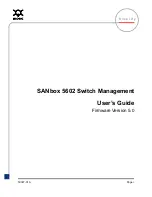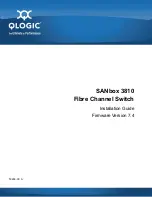
Chapter 12
| Security Measures
Configuring 802.1X Port Authentication
– 347 –
In this mode, each host connected to a port needs to pass authentication.
The number of hosts allowed access to a port operating in this mode is
limited only by the available space in the secure address table (i.e., up to
1024 addresses).
◆
Max Count
– The maximum number of hosts that can connect to a port when
the Multi-Host operation mode is selected. (Range: 1-1024; Default: 5)
◆
Max Request
– Sets the maximum number of times the switch port will
retransmit an EAP request packet to the client before it times out the
authentication session. (Range: 1-10; Default 2)
◆
Quiet Period
– Sets the time that a switch port waits after the Max Request
Count has been exceeded before attempting to acquire a new client.
(Range: 1-65535 seconds; Default: 60 seconds)
◆
Tx Period
– Sets the time period during an authentication session that the
switch waits before re-transmitting an EAP packet. (Range: 1-65535;
Default: 30 seconds)
◆
Supplicant Timeout
– Sets the time that a switch port waits for a response to
an EAP request from a client before re-transmitting an EAP packet.
(Range: 1-65535; Default: 30 seconds)
This command attribute sets the timeout for EAP-request frames other than
EAP-request/identity frames. If dot1x authentication is enabled on a port, the
switch will initiate authentication when the port link state comes up. It will
send an EAP-request/identity frame to the client to request its identity,
followed by one or more requests for authentication information. It may also
send other EAP-request frames to the client during an active connection as
required for reauthentication.
◆
Server Timeout
– Sets the time that a switch port waits for a response to an
EAP request from an authentication server before re-transmitting an EAP
packet. (Default: 0 seconds)
A RADIUS server must be set before the correct operational value of 10 seconds
will be displayed in this field. (See
“Configuring Remote Logon Authentication
◆
Re-authentication Status
– Sets the client to be re-authenticated after the
interval specified by the Re-authentication Period. Re-authentication can be
used to detect if a new device is plugged into a switch port. (Default: Disabled)
◆
Re-authentication Period
– Sets the time period after which a connected
client must be re-authenticated. (Range: 1-65535 seconds; Default: 3600
seconds)
◆
Re-authentication Max Retries
– The maximum number of times the switch
port will retransmit an EAP request/identity packet to the client before it times
out the authentication session. (Range: 1-10; Default: 2)
Summary of Contents for GTL-2881
Page 34: ...Section I Getting Started 34 ...
Page 48: ...Section II Web Configuration 48 Unicast Routing on page 651 ...
Page 151: ...Chapter 4 Interface Configuration VLAN Trunking 151 Figure 69 Configuring VLAN Trunking ...
Page 152: ...Chapter 4 Interface Configuration VLAN Trunking 152 ...
Page 230: ...Chapter 8 Congestion Control Automatic Traffic Control 230 ...
Page 596: ...Chapter 14 Multicast Filtering Multicast VLAN Registration for IPv6 596 ...
Page 620: ...Chapter 15 IP Configuration Setting the Switch s IP Address IP Version 6 620 ...
Page 672: ...Section III Appendices 672 ...
Page 678: ...Appendix A Software Specifications Management Information Bases 678 ...
Page 688: ...Appendix C License Statement GPL Code Statement Notification of Compliance 688 ...
Page 696: ...Glossary 696 ...
Page 706: ...GTL 2881 GTL 2882 E112016 ST R01 ...
















































